The materials for the manufacture of aprons for the kitchen from mosaics can be used in a variety of ways, from traditional glass that has been used for many centuries to modern plastic. They have one requirement: they must withstand specific conditions: high humidity, temperature changes, the effect of aggressive environments and harsh detergents. In accordance with these requirements, materials for kitchen mosaics are used basically the same as for tiles.
The size and shape of the mosaic for the apron in the kitchen
- The size. Ceramic tiles, as well as tiles made of other materials for facing the working area in the kitchen, are usually not less than 10x10 cm, and more often they use a larger one, 20x20 cm. The size of one mosaic element starts from 10 cm on one side, and then decreases to 1 cm. The most popular tiles are a kitchen apron for mosaics, having a size of 2 to 5 cm on one side.
- The form. Mosaic can be square, round, rhombic, trapezoidal, oval and even have the form of irregular polygons. The more complex the shape of each element is, the more difficult it will be to lay out an apron from a mosaic, so square tiles are the most popular.
Mosaic for the kitchen is sold, unlike tiles, not with separate elements, but with “matrices” - an assembled mosaic of small elements is glued onto a suitable base. As a rule, the matrices are in the form of squares with a size of about 30 cm. Depending on the pattern and manufacturer, the size can vary by a couple of centimeters, both in plus and minus, which introduces adjustments in the calculation of materials needed for cladding.
Colors and shades of mosaic apron elements
The variety of colors and shades of the elements from which the mosaic is laid out is very large. You can find several dozen shades of the same color, different in saturation and tone.
Monochrome, that is, one-color mosaics, assembled from tiles of the same color, of varying degrees of saturation, are used in the form of "stretch marks" - stripes of the same color, gradually changing intensity. Most often lay out a multi-color mosaic, which is created using tiles of different colors, shades, and sometimes even textures and sizes.
Quite often you can find on sale ready-made sets of elements deposited on a substrate and forming various patterns, this is a fairly budget option. To assemble mosaic panels to order according to your desire or designer's sketch will be more expensive.
Important: The cost of the mosaic can be calculated per square meter, but it can also be indicated for one separate fragment, for example, for one matrix (usually 30x30 cm in size) or one stretch strip (usually 260x32 cm).
Mosaic apron design
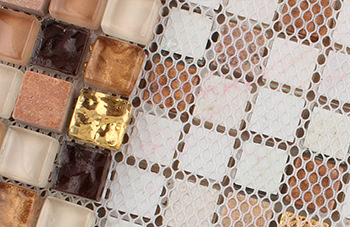 Mosaic can lay out almost any pattern. Decorate the kitchen with luxurious colors, scenes of village life or abstract patterns - you need to decide in accordance with the style of the whole room and the desired effect.For example, a mosaic panel above the work surface can become the main decorative accent, and can have a supporting role, creating an unusual background for demonstrating the latest innovations in kitchen appliances. The main disadvantage of mosaic design is the rather high price. But you can save, following the advice of experts:
Mosaic can lay out almost any pattern. Decorate the kitchen with luxurious colors, scenes of village life or abstract patterns - you need to decide in accordance with the style of the whole room and the desired effect.For example, a mosaic panel above the work surface can become the main decorative accent, and can have a supporting role, creating an unusual background for demonstrating the latest innovations in kitchen appliances. The main disadvantage of mosaic design is the rather high price. But you can save, following the advice of experts:
- Use ready-made mosaic sets. There are interesting options in which elements from different materials are combined, for example, stone, metal and glass. The finished version is always cheaper than the exclusive one.
- Keep track of sales. At reduced prices, you can buy the remains of an expensive high-quality mosaic, which can then be combined in one way or another.
- Use fragments of the mosaic as a decoration, and lay the rest of the apron with ordinary ceramic tiles.
- Instead of mosaic matrices, you can lay out the wall surface with a “mosaic” tile - it looks no worse, but costs less, besides laying mosaics in the kitchen is a more expensive process than laying tiles.
Important: Mosaic matrices can be laid on a grid or on a paper base. They differ from each other by the installation method. During installation, glue is applied to the grid and mounted on the wall. The mosaic on the paper is fixed to the wall with the free side, and the paper is then soaked and removed.
Glass mosaic apron
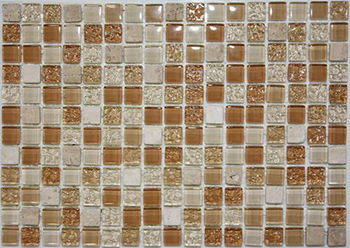
Glass is a very popular and relatively inexpensive material for making mosaics. Pieces of glass can be either transparent or opaque, have almost any color. The most commonly used shape is a square with a side of 1, 1.5 or 2 cm and a thickness of not more than 4 mm. Mosaic glass is made of quartz sand, adding coloring substances - pigments. To enhance the shine, pearl or aventurine is introduced into the molten glass. Additionally, decorative materials in the form of crumbs are sometimes added.
Manufacturers sell mosaics not in separate elements, but in matrices - assembled into squares with a side of about 30 cm sheets, ready to be fixed to the wall. Matrices can be monophonic, have monochrome gradient color transitions, but the most popular are multi-colored matrices and matrices that form some kind of pattern.
The price of a glass mosaic for a kitchen on an apron depends on the complexity of manufacturing its individual elements. The easiest way is to make a plain, soft colors - for example, beige. It costs less. The more colors and shades the mosaic has, the brighter they are, the more expensive the finished apron will be. Like any material, glass has its pros and cons when used as a wall covering in the kitchen.
pros
- The main plus is affordability.
- In addition, it is a very practical and environmentally friendly material that does not emit harmful substances into the atmosphere.
- The smooth surface of the glass does not absorb dirt, does not allow bacteria and fungi to multiply, withstands long-term operation without loss of properties and appearance, despite the high humidity and temperature changes.
- In addition, pieces of glass of small size, fixed on the base, are quite resistant to shock, in contrast to other types of glass, for example, window glass.
Minuses
- In order for the mosaic apron to serve for a long time and not fall off onto the desktop, it needs to be laid on very high-quality glue, and the joints should be strengthened with a special grout. The materials are expensive, so installation will require serious expenses.
Mounting
During installation, special attention is paid to materials - glue and grout. Glue is preferable to choose white color - it will not affect the final result. This is especially important if at least part of the mosaic panel is composed of transparent or translucent elements. Colored glue is used if the mosaic for the kitchen is opaque and monochrome.
To qualitatively fix the glass mosaic on the apron, it is necessary to use glue with high adhesion - at least 20-28 kg per square centimeter.The fact is that the glass has an absolutely smooth surface, to which other substances “stick” poorly. This is a big plus - because dirt is easy to wipe off. But this is also a minus - it is difficult to fix it on the wall quite reliably.
The quality of the mosaic apron also depends on the quality of the grout. Choose those that are resistant to high humidity and aggressive environments. Epoxy grouts are considered most suitable. They are more difficult to work with, but they are very resistant to negative external conditions and have a high degree of adhesion.
Tip: A light gray grout is best suited for colored mosaics - it will be almost invisible.
Ceramic mosaic apron
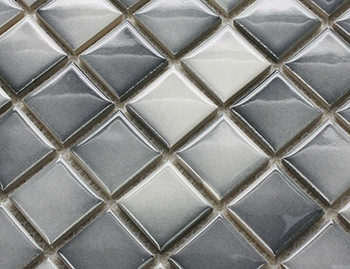 Instead of glass, in the manufacture of mosaics, you can use ceramic mass - exactly the same as in the production of ordinary tiles. It will have all the properties of a tile, with the exception of features due to the size of its constituent elements. They make a ceramic mass of clay with the addition of sand, pigments and other components that provide strength, color and ductility. Ceramics can be painted in any color, it practically does not fade, withstands harsh operating conditions. Caring for her is easy and simple.
Instead of glass, in the manufacture of mosaics, you can use ceramic mass - exactly the same as in the production of ordinary tiles. It will have all the properties of a tile, with the exception of features due to the size of its constituent elements. They make a ceramic mass of clay with the addition of sand, pigments and other components that provide strength, color and ductility. Ceramics can be painted in any color, it practically does not fade, withstands harsh operating conditions. Caring for her is easy and simple.
Ceramic mosaic on the kitchen apron will not lose its attractive appearance for a long time. The surface of each element is glazed, so dirt cannot penetrate into the pores of the material, which means that it will be easy to care for the apron.
Ceramic differs from glass mosaic in a more expressive texture, also in thickness - it cannot be less than 8 mm. This must be considered when planning repairs. There is one minus - an apron made of ceramic mosaic will cost more than a tiled one, despite the fact that the material for it is the same.
Ceramic mosaics come on sale with matrices - squares with a side of 30 cm. In addition, each element can be from 1 to 10 cm on the side. Elements can be not only square, triangles, octagons, hexagons (honeycombs) are very popular, as well as in the form of natural formations, for example, shells or coastal pebbles. The surface can also imitate natural materials or artificial decorative effects, such as craquelure.
Mosaic from a stone on an apron
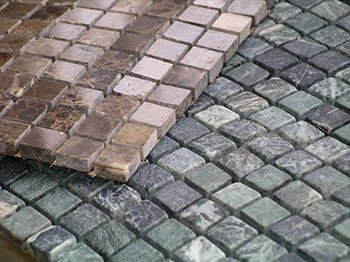 The strength and resistance of the stone to any influences make it a unique material, almost unmatched. Stone mosaic for the kitchen is unusually aesthetic and gives the room solidity and exclusivity. To create it, pieces of marble, limestone, tuff, travertine saw cuts are used. The most expensive mosaic is obtained from ornamental stones - onyx, lapis lazuli, malachite. The surface of the stone is polished, or left matte - depending on the designer's intent.
The strength and resistance of the stone to any influences make it a unique material, almost unmatched. Stone mosaic for the kitchen is unusually aesthetic and gives the room solidity and exclusivity. To create it, pieces of marble, limestone, tuff, travertine saw cuts are used. The most expensive mosaic is obtained from ornamental stones - onyx, lapis lazuli, malachite. The surface of the stone is polished, or left matte - depending on the designer's intent.
Which stone to prefer? Those that have a porous structure are not suitable - they will absorb kitchen odors and dirt, caring for them is very difficult, and such an apron will lose its appearance very quickly. Therefore, limestone or travertine for the kitchen is better not to use. Marble and granite are denser materials, but even they can absorb dyes contained, for example, in carrot or beetroot juice.
In order to protect the stone from penetration of foreign substances, it can be treated with a special impregnating composition. A feature of mosaics made of stone on an apron is fastening on a grid as a basis. Other materials are not used for this.
For different manufacturers, the dimensions of the matrices may vary by one and a half to two centimeters, so carefully check the size of the selected matrix and calculate the required number, taking into account this real size! As a rule, stone elements have a square shape with a side of 3 to 5 cm, but you can also find rectangles of different formats. Sometimes stone elements are used in mosaic mixes in order to obtain the effect of contrasting surfaces.
Porcelain mosaic apron
This type of kitchen mosaic apron has several differences. Firstly, its elements are a plate divided into fragments, and not fragments cast in forms. Secondly, it looks like a mosaic of stone, but it is much cheaper.
As a rule, they produce porcelain stoneware tiles “under the mosaic” measuring 30x30 cm and have recesses on the surface. After laying and grouting, the illusion of a real mosaic panel is created. Such tiles can be put on ordinary glue suitable for porcelain stoneware, which is cheaper than special mosaic tiles. The same applies to the grouts used.
Mosaic from metal on an apron
One of the most exotic and spectacular materials for creating mosaics is metal. For the manufacture of brass and stainless steel, the elements are mounted on plastic, rubber or ceramics. Most often, elements of a square shape are used, but not uncommon and rhombic, and hexagonal.
An apron for the kitchen of mosaics, fragments of which are made of metal, opens up great opportunities for the designer. The surface of the elements can be shiny or matte, have a relief, a notch, a convex pattern. The color scheme is gold, old bronze, shiny chrome or silver titanium.
The main drawback of such a surface is its brilliance, on which all impurities are clearly visible, even drops of water. To facilitate the care of the apron in the kitchen, it can be made of brushed metal. If you choose a kitchen apron from a mosaic in the color of gold, but there is no desire to complicate your homework, you can replace the metal elements with glass ones that imitate a gold surface. They will look almost the same, but caring for glass is much easier, and it costs less.
Although metal and a durable material, it is susceptible to corrosion, luster disappears with time, and scratches may appear. But all these shortcomings "pay off" with a magnificent appearance.


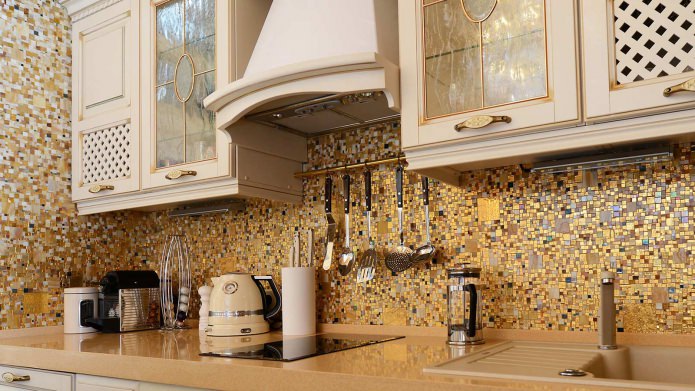
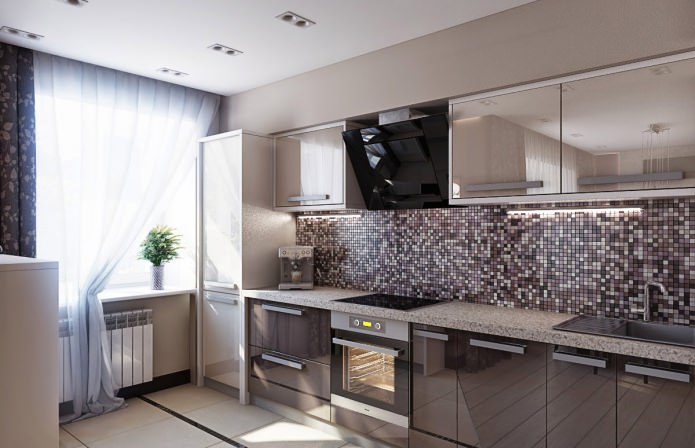

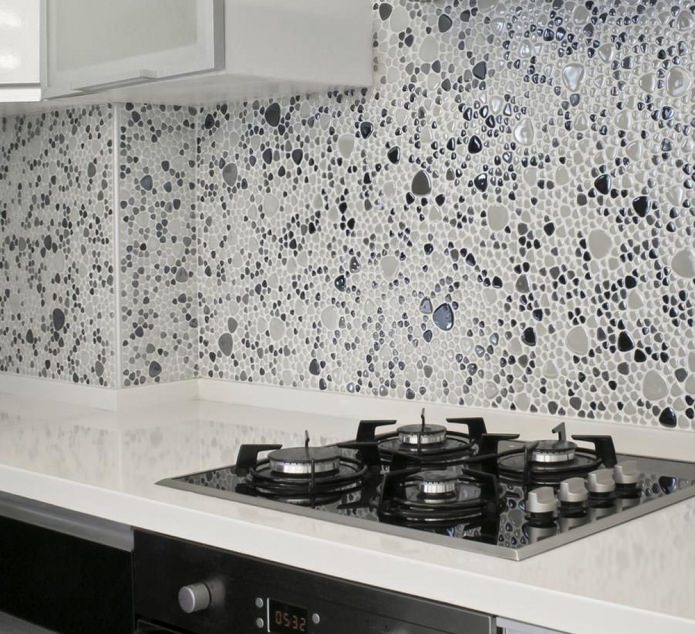

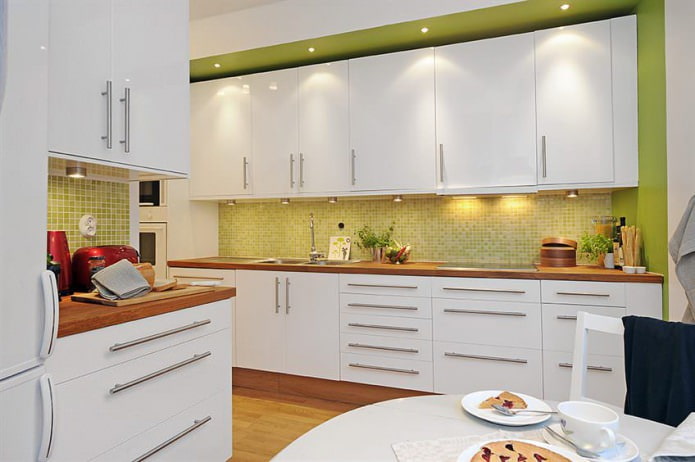
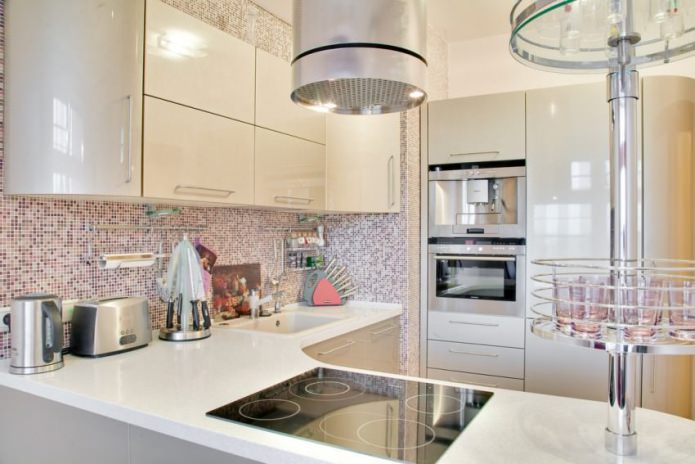
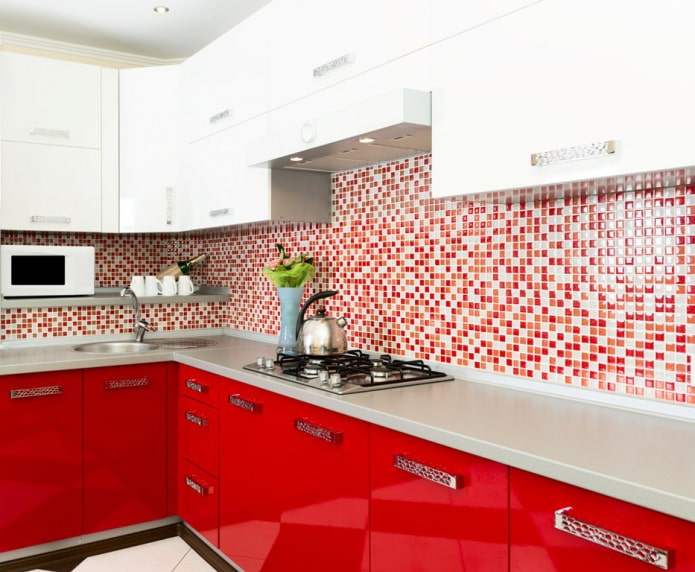
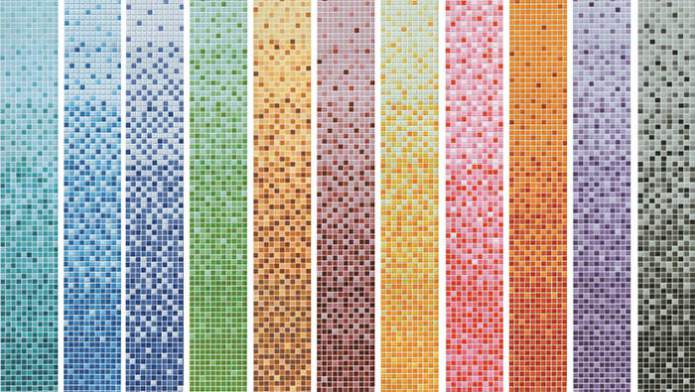
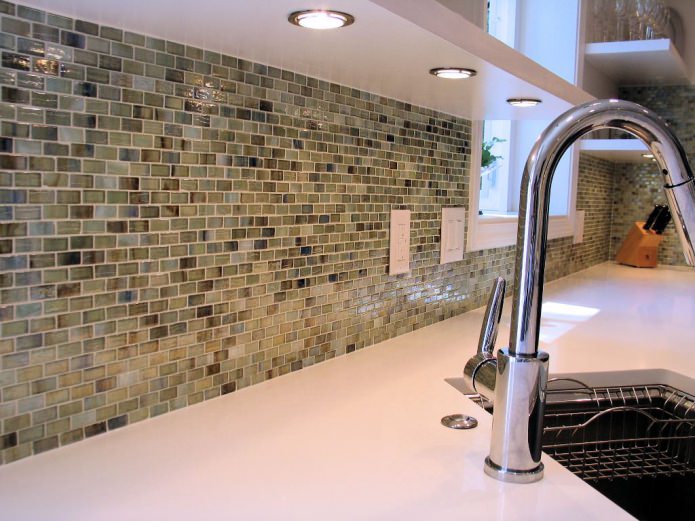


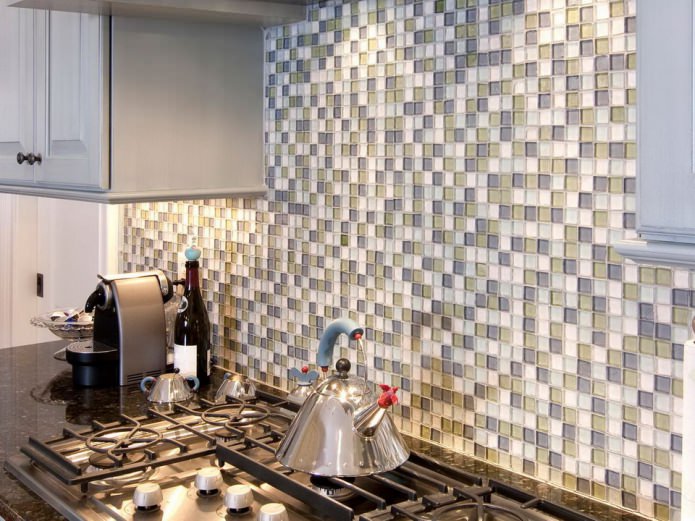
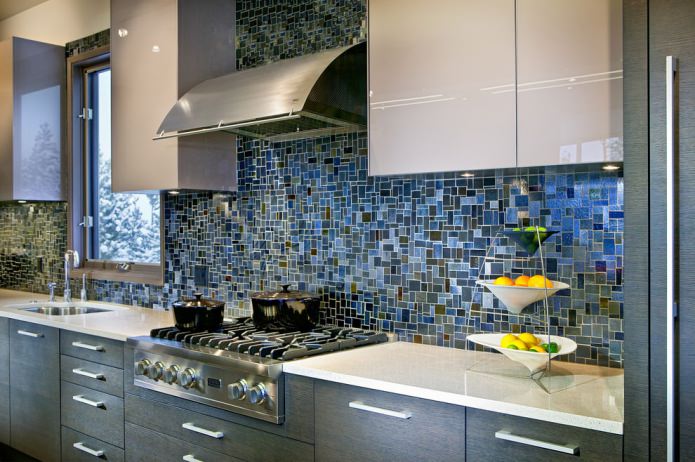
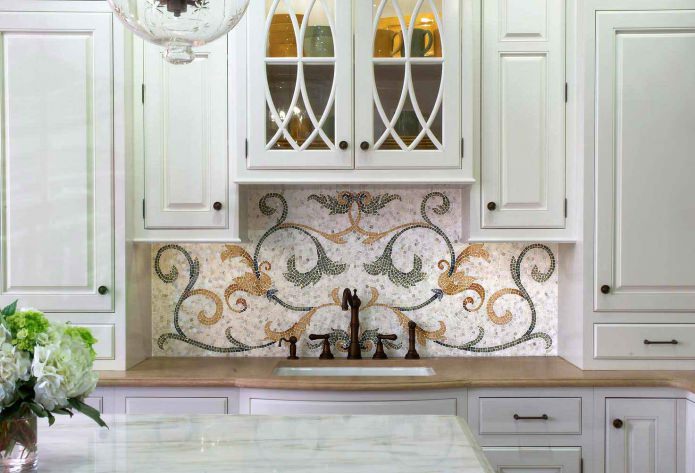



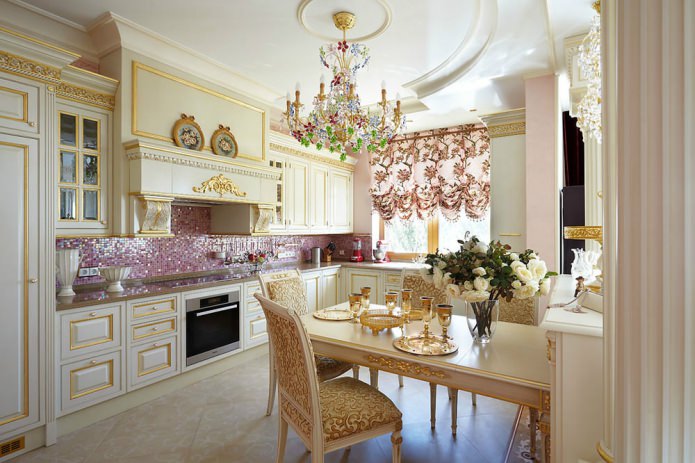
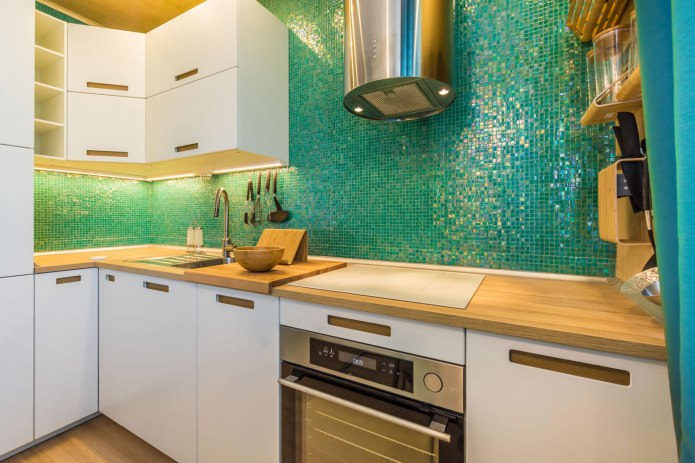
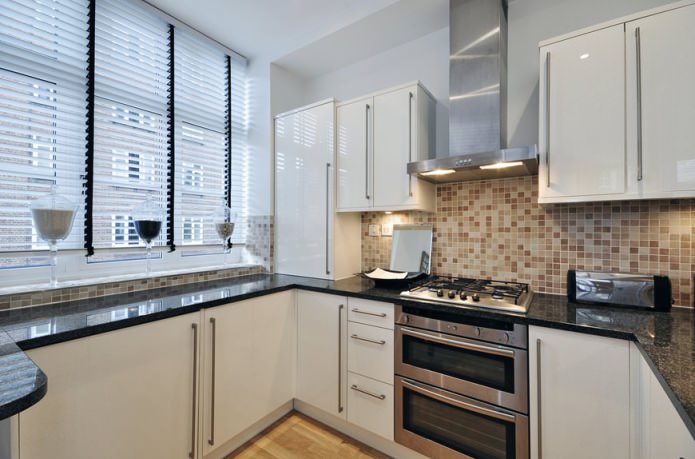
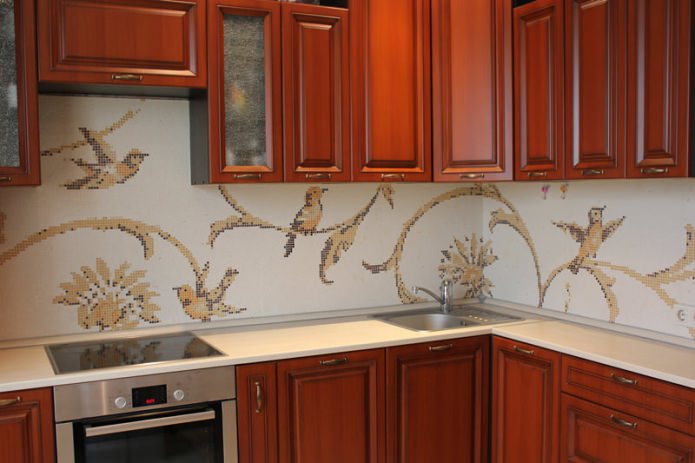


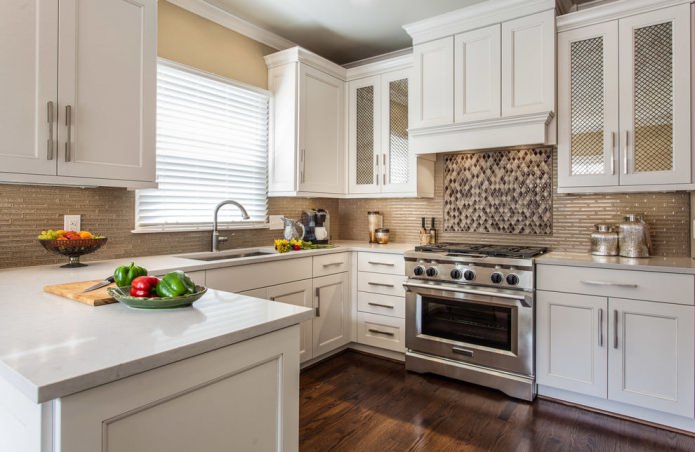

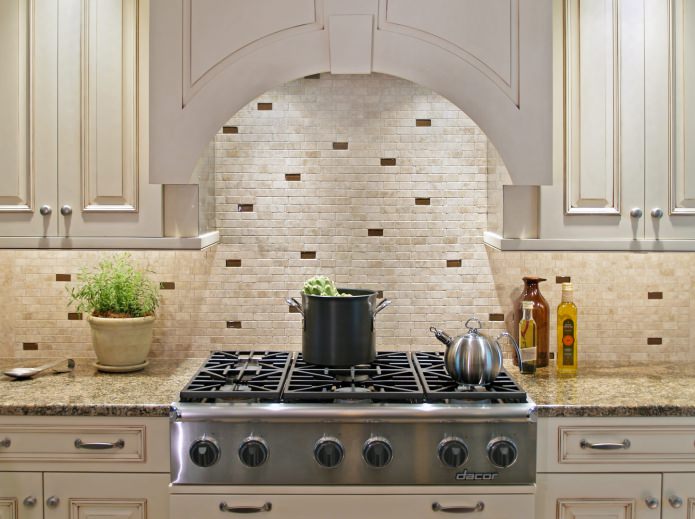
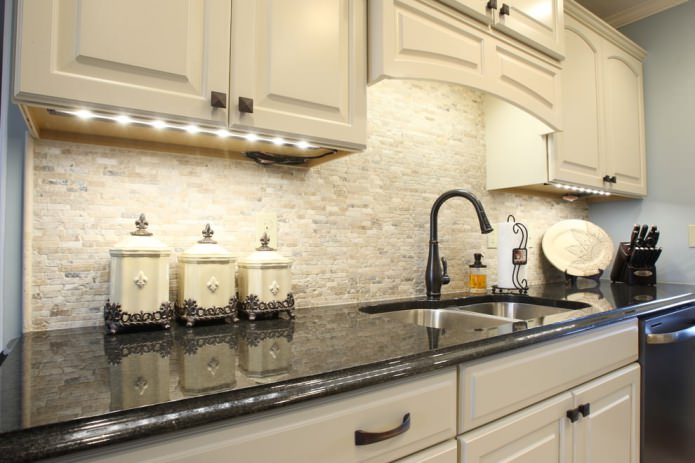
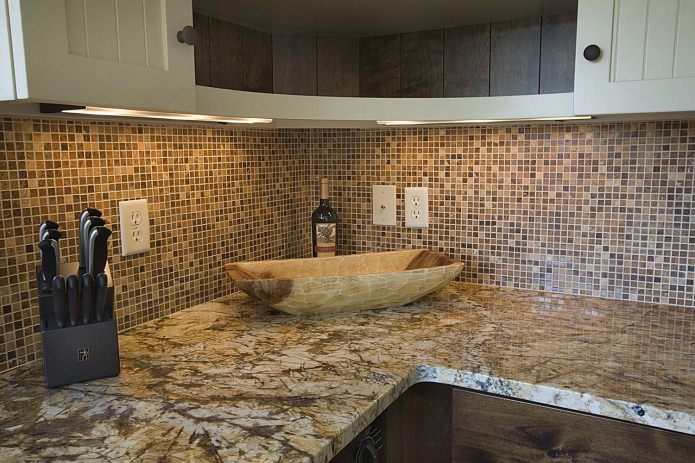
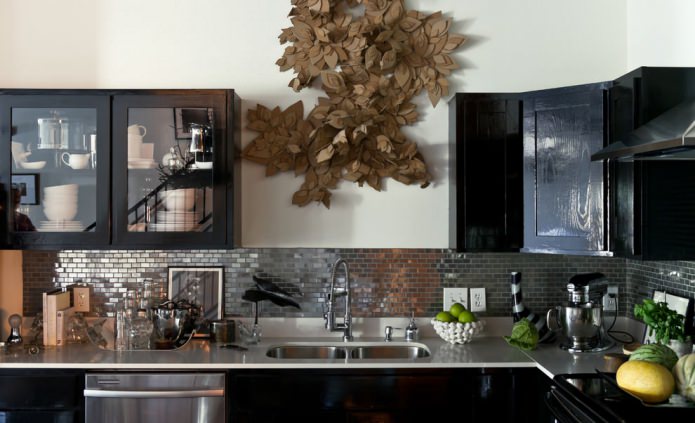

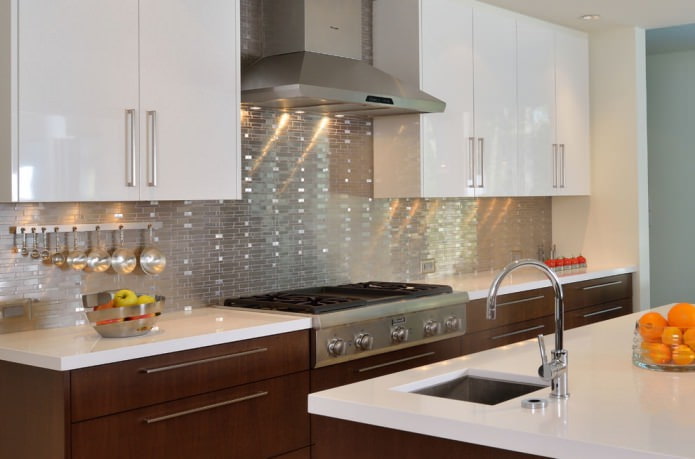

 How to choose the color of the sink for the kitchen?
How to choose the color of the sink for the kitchen? White kitchen: features of choice, combination, 70 photos in the interior
White kitchen: features of choice, combination, 70 photos in the interior Black suite in the interior of the kitchen: design, choice of wallpaper, 90 photos
Black suite in the interior of the kitchen: design, choice of wallpaper, 90 photos Modern design ideas for curtains for the kitchen - we make out the window stylish and practical
Modern design ideas for curtains for the kitchen - we make out the window stylish and practical Wallpaper design: 65 photos and ideas for a modern interior
Wallpaper design: 65 photos and ideas for a modern interior Design of a white kitchen with a black countertop: 80 best ideas, photos in the interior
Design of a white kitchen with a black countertop: 80 best ideas, photos in the interior